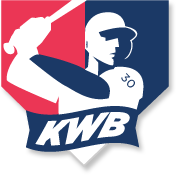The idea was hatched in 2013 when I sat down with my good friend Joe Ferraro and asked him if he wanted to host a podcast with me. The vision was to bring value in terms of thought processes, techniques, mindsets and methodologies to the serious baseball player and coach, as well as the casual fan looking for insights into the game they couldn’t get anywhere else.
Truth be told, in the beginning it was Joe educating me on what a podcast was. Before we launched, I had never listened to a podcast but I knew it could be a great way to reach players and coaches on a more personal level. At the time, podcasts were still an unknown platform that could bring a lot of value to listeners – value that they could trust.
We launched Episode 1 of KWB Radio on August 1, 2014 with guest and good friend Charlie Manuel – manager of the 2008 World Series Champion Philadelphia Phillies.
And since then, it’s been an incredible ride with great guests inside the game of baseball talking about not only hitting, but we are placed inside the lives of players and coaches on and off the diamond.
The purpose of KWB Radio is to take you behind the scenes and into the clubhouse with some of the brightest minds in the game today.
Some of the names you will recognize, but some of my favorites conversations have been with the names you may not be familiar with before you press play.
We share stories about adversity, we find out WHY they do what they do and learn HOW they got to where they are in the game.
They provide countless examples and principles for success on and off the field.
We highlight those stories and bring them to life for you in 40-60 minute episodes.
In 2017 we took a break for a few months. We recently released Episode 46 – Where Do Home Runs Come From? and the response has been overwhelming. We used to joke in the first few episodes that “no one is listening anyway.” But we quickly found out that, in fact, a lot of people were starting to listen – and many more continue to listen today.
You just never know what to expect when you come back from a break like we did. But it’s another reminder of how much we appreciate our loyal listeners. We are so thankful because without you, we don’t have a show.
Joe and I are so grateful for your support, your emails, your suggestions and your 5-star ratings and reviews. We love to get in the studio and talk shop and we are serious when we say that even if nobody was listening, we would still have a blast doing what we do.
If you are new to KWB Radio, subscribe to the show in iTunes or Stitcher and never miss another episode.
We are excited to continue to provide value through our first class guests and quality content. If you like what you hear, please share the show with someone you care about.
All it takes is 5 minutes to change someone’s life.
For more than a decade, Kevin Wilson has been one of the most respected hitting coaches in the game. He works behind the scenes as a private hitting consultant to some of the best hitters in Major League Baseball. In 2013, Kevin was the hitting coach for the USA Baseball 18U National Team. Team USA beat Japan for the Gold medal at the IBAF World Cup in Taichung, Taiwan.
He is the author of the Amazon #1 Best Seller The #GoodBatting Book and co-hosts a popular podcast, KWB Radio, that showcases unique conversations with the pros. If you want Kevin to speak at your next event or if you want take advantage of his popular 2-day KWB Experience for players and coaches, contact Kevin today!
Follow Kevin on twitter @KWBaseball and visit his website KWBaseball.com
